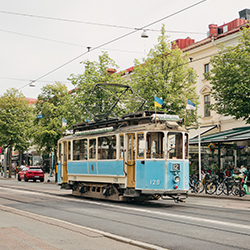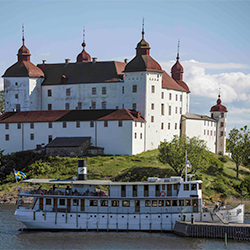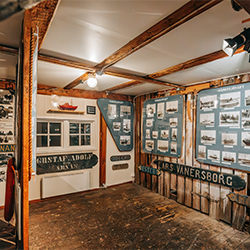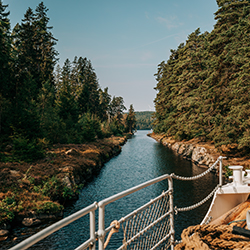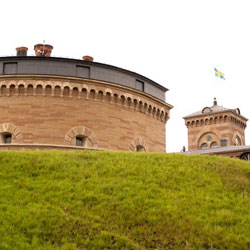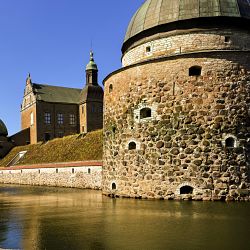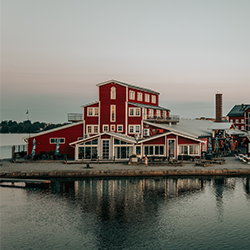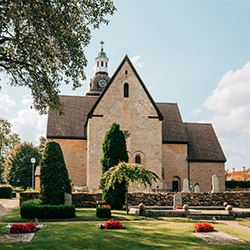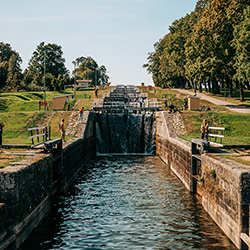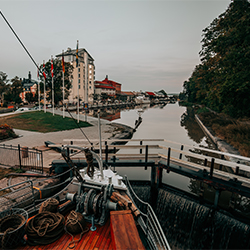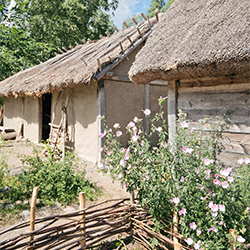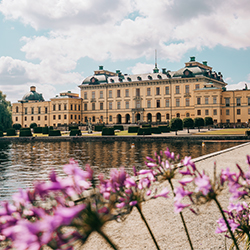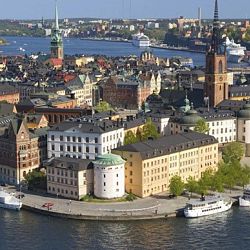Along the route there is so much to see, one can really say that with us, the journey is more important than the destination. Sweden’s cultural landscape with farms, animals and fields as well as castles and manors are to be seen along the route. We are travelling through locks and over aqueducts, we’ll also visit famous sights as the Abbey in Vadstena, the Canal Museum in Trollhättan and the fascinating Läckö Castle.
Gothenburg is the second largest city in Sweden and the fifth largest city of the Nordic countries. Gothenburg is situated on the beautiful West Coast, at the mouth of the River Göta. Many of our canal cruises start or end at Packhuskajen 10 in Gothenburg, where the old Customs House from 1867 is located.
The Trollhättan Canal Museum is located in a storehouse from 1893. Learn more about the fascinating history of the Trollhätte Canal through the interesting exhibition and film shown here. You can also take a walk through the idyllic lock area with the old locks from the 19th century. The impressive lock staircase at Trollhättan consists of four locks, and has a total drop of 32 metres. Of the three parallel lock systems here, only the biggest one (from 1916) is still in use.
Läckö Castle is situated on a promontory in Lake Vänern. It was built as a fortified bishop's castle in 1298 and during the mid-17th century, the castle was transformed into Baroque style. After standing empty for 150 years, the castle is now experiencing a renaissance with a rich cultural life and a great deal of work has been done to restore the castle to its former glory.
On the Grand Sweden Cruise there will be a guided tour of the castle and the exhibitions (lots of stairs), app. 1-km walk.
Photographer: Simon Irvine
At Sjötorp there is a set of eight locks, and also the remains of some old shipyards. On the Grand Sweden Cruise and the Classic Canal Cruise (from Stockholm) and Göta Canal Highlights (from Norsholm) we visit the old warehouse, where you can find a shop selling, among other things, clothes and home décor, a café and the Sjötorp Canal Museum. In the museum you can see old pictures of Sjötorp, the interiors of several old ships, and also learn more about the building of the canal. There is also a map of all the sunken ships in the Lake Vänern. Enjoy a lovely walk along the locks.
We pass a lock system consisting of four locks in beautiful surroundings. In 1822 the western section of the Göta Canal was inaugurated at Hajstorp. Here is the Canal Engineer’s home, now privately owned and the old smithy. On our cruise Göta Canal Highlights (from Mariestad) you will have the opportunity to join the tour guide on a guided walk along the locks.
On the Grand Sweden Cruise from Stockholm we dock for the night in Hajstorp.
The beautiful spellbinding Lake Viken (91.8 metres above sea level) serves as a water reservoir for the western section of the Göta Canal. We steer through two of the canal´s narrowest passages - the Spetsnäs Canal and Billströmmen. Both wood-lined and surround with small lakes full of water lilies.
Forsvik is one of Sweden’s most interesting industrial communities. For six hundred years, iron has been worked, boards have been sawn and flour has been milled here. Historical buildings used for fine metalwork, a foundry and a wood pulp mill are found in this beautiful and unique environment. Exciting and informative displays tell about metalworking, engineering and life in this industrial community.
On the cruise Göta Canal Highlights with M/S Wilhelm Tham we get to enjoy an interesting guided tour. If we are lucky the paddle steamer Eric Nordevall II will be moored in the harbour. The paddle steamer is a full-scale replica of the Eric Nordevall, one of Sweden’s first power-driven ships. The paddle steamer was built in 1836, but sunk 20 years later in Lake Vättern. It was rediscovered in 1980 at a depth of 45 metres. The Eric Nordevall II was launched in 2009 and made its first trip in 2011.
We pass Karlsborg, which is located by the western shore of Lake Vättern. On the Classic Canal Cruise we visit the Karlsborg Fortress, which was initiated by Baltzar von Platen and built in 1819-1909. The fortress was intended to be used as the reserve capital of Sweden and house the royal family, the government, the gold reserves and the crown jewels in the event of war. Here you can enjoy an interesting guided tour of the fortress and the beautiful Garrison Church.
Vadstena flourished around the 14th century convent of Saint Bridget (Heliga Birgitta), becoming a spiritual, cultural and commercial centre. Vadstena Abbey Church was built according to St. Bridget's plans and was consecrated in 1430. The present castle was built in the 1540s by King Gustav Vasa. Today Vadstena is an idyllic little town. On the Grand Sweden Cruise local guides will meet us and take us with a sightseeing train to see the Abbey and the castle.
It was Baltzar von Platen who drew up the plans for Motala, and today it is called “the Capital of the Göta Canal”. In 1822 an engineering works, Motala Werkstad, was established here to serve the Göta Canal and is today considered to be the cradle of Swedish industry. Here you also find the head office of the Gota Canal Company, responsible for operation and maintenance. We visit the Motor Museum, with its large exhibition of antique cars and motorcycles in authentic surroundings, collection of radios, toys, household appliances and more. You can also walk to see Baltzar von Platen’s grave, about 1 km along the left side of the canal.
On the cruises Grand Sweden Cruise and Göta Canal Highlights you have the chance to visit the Motala Motor Museum, with its large exhibition of antique cars and motorcycles in authentic surroundings.
On the Grand Sweden Cruise and the Classic Canal Cruise we dock for the night in Motala. The Mini Canal Cruise starts or ends in Motala.
The convent of Vreta dates from about 1100 and was the first nunnery in Sweden. Its importance was later superseded by the convent founded by Saint Bridget (Saint Birgitta) at Vadstena. The old convent church at Vreta is one of Sweden's most interesting, offering many medieval treasures. Today, it is used as a parish church and is therefore not always open to visitors.
On the Classic Canal Cruise and the Grand Sweden Cruise you have the option of joining the tour guide on a walk (app. 3 km) to the ruins of the convent of Vreta and to the church. As an alternative you can walk along the canal on your own or take a swim in Lake Roxen.
The Carl Johan lock staircase is the longest in the canal with seven connected locks. This lock staircase will lower or raise the boat 18.8 metres.
On the Grand Sweden Cruise from Stockholm we dock for the night by the bottom lock.
The idyllic town Söderköping was founded in the early 1200s and was very important during the Hanseatic period. The town also has a long and interesting history as a spa. Today, it is also known for its ice cream parlours. The Mini Canal Cruise starts or ends in Söderköping.
On the Grand Sweden Cruise we make a stop at the ruins of Stegeborg Castle, which is beautifully situated on a small island overlooking the bay of Slätbaken. The castle was constructed during the early Middle Ages and was built to guard the inlet to Söderköping. We are given an exciting guided tour of the castle ruin and herb garden. The walk is short, but somewhat uneven.
0.3 metres above sea level. In the Viking age, Sweden's third largest lake wasn't a lake, it was a part of the Baltic Sea. Here boats could sail far into Sweden to reach the many cities around the coastline making Mälaren a very important fairway and trading route. Around 1200 the mouth of Mälaren had become so shallow that boats had to be dragged over it to pass. It was about the same time that Sweden's capital Stockholm was founded on that very spot. In Lake Mälaren there are two UNESCO World Heritage Sites - Drottningholm Palace where the King and Queen of Sweden live and Birka, the Viking City.
On the Classic Canal Cruise and the Grand Sweden Cruise (cruises departing from Gothenburg) we make a stop at Birka the Viking City. The Viking community of Birka on the island of Björkö is often regarded as Sweden's first town. The town was then an important harbour for international shipping and trade. It was in use for about 250 years and was abandoned before the year 1000. Birka features on UNESCO'S World Heritage list. There will be a guided tour around on the island (app. 3 km, uneven terrain), and we also visit the museum.
Influenced by French prototype, the Drottningholm Palace was built by architect Nicodemus Tessin the Elder. It is the most well-preserved royal castle built in the 1600s in Sweden. Since 1981 the Palace is Their Majesties the King and Queen's residence. Drottningholm Palace is also found on the World Heritage list. We will pass the palace if time permits.
The Grand Sweden Cruise and the Classic Canal Cruise start or end in Stockholm, the capital of Sweden. The ships are docked at Skeppsbrokajen 103, Gamla Stan.

